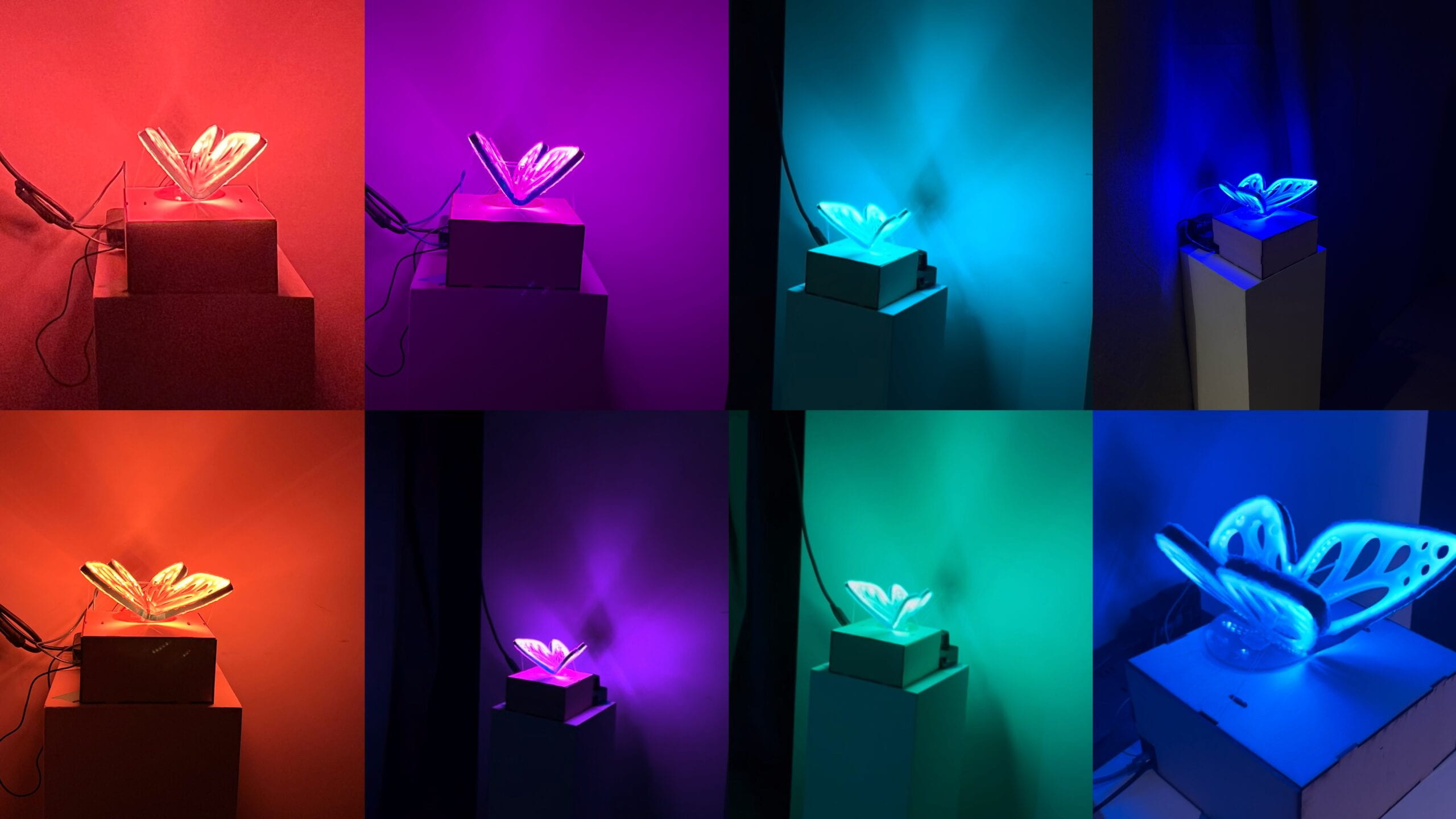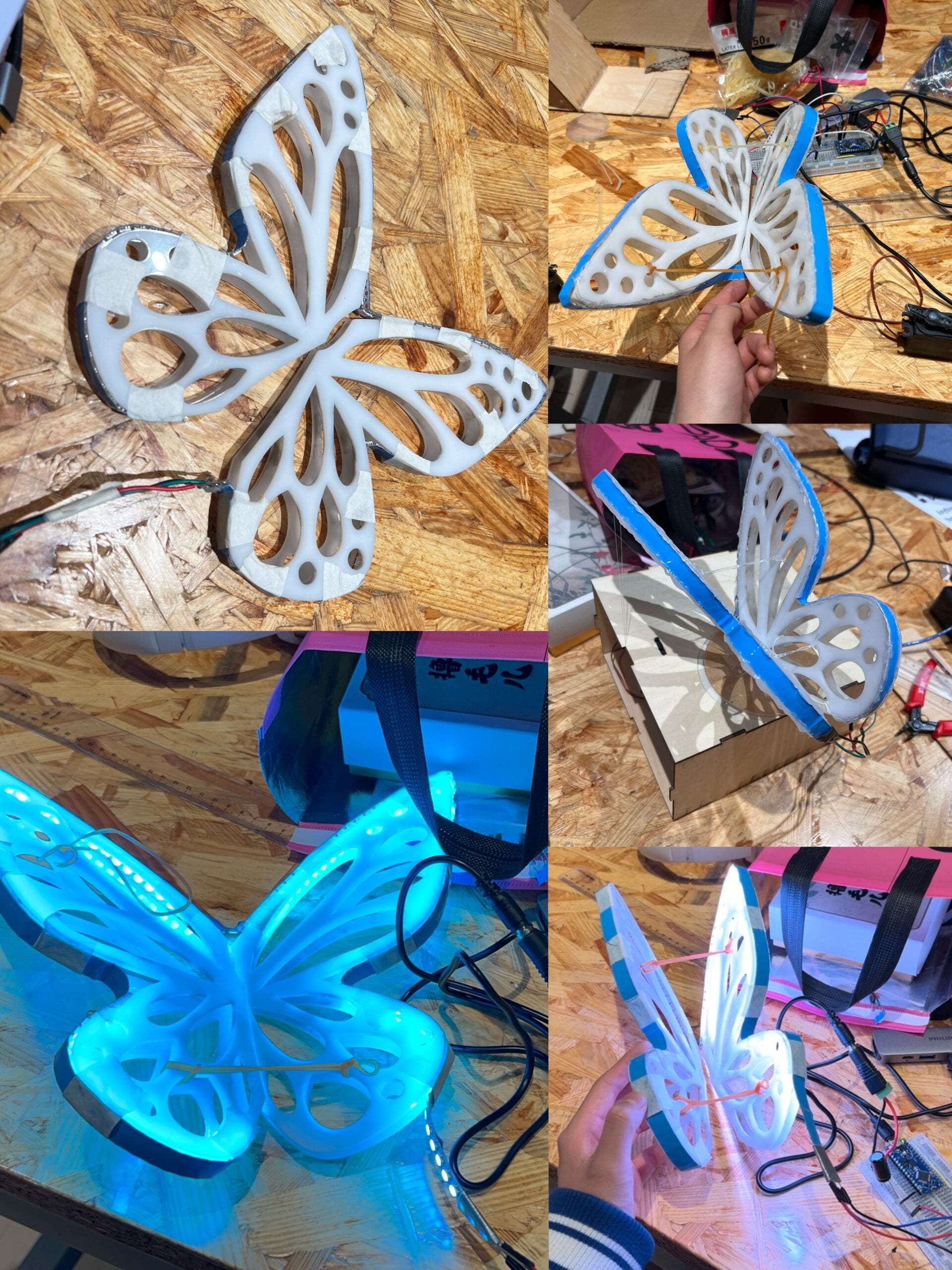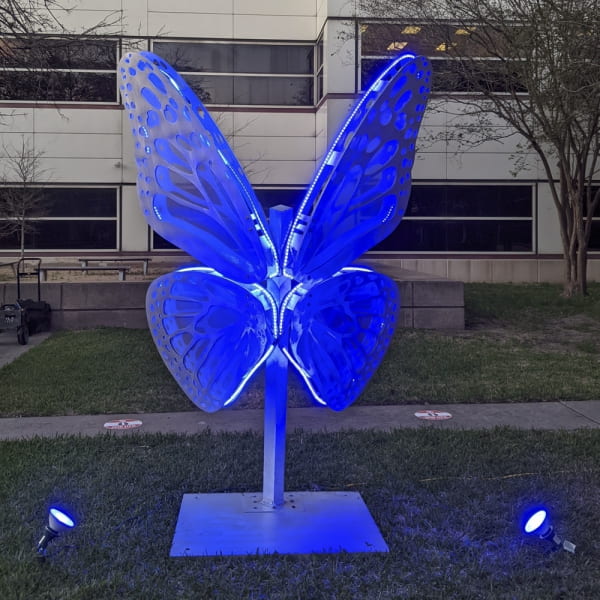Project Description
This project is called “Spectrum Butterfly🦋”, which is in combination with light and movement. Standing on a 25*25cm wooden box, the wings of the butterfly are made of 4 pieces of semitransparent acrylic board, two on the right, and two on the left. Between each pair on the same side is a CRGB-led strip attached in the middle.
There are two transparent acrylic hinges, which limit the range of the wings’ movement, attached to the bottom of each wing. On the two sides of the project, two MS196 servos control the movement of the wings. The fishline serves as the connection between servos and wings. Transparent elastic bands are tied between two wings, functioning as stabilizers.
Building process:
My inspiration for this project came from an artwork “Love Motels for Insects” by artist Brandon Ballengée. The picture of the artwork is attached below. But for my project, I use a CRGB-led strip rather than using ultraviolet as the light source. For the wings’ movement, I chose servos because I think they are easy to control.
Perspective and Context
This project fits into the context of art and perception, light art, and kinetic art. Broeckmann mentioned in his book that “Long live art, the art of the machine with its construction and logic, its rhythm, its constituent parts, its material, its metaphysical spirit—the art of the ‘counter-relief’” (2017). Different from a plain sculpture, this project incorporates various materials and elements including lights, movements, and aesthetics. Driven by two servos, the wings move rhythmically as their colors change, making the butterfly look beautiful and alive.
Kinetic Construction is an artwork produced by Naum Gabo in 1920. It contains a vibrating electrical motor attached to a vertically erect length of flat spring steel, weighted slightly on the upper end. It well-showcased what simplicity was. In a document, Gobo pointed out that kinetic rhythms are new forms of kinetic art, they can act as the basic forms of our perception of real-time. Servos that drive wings to move and the transition of colors provided by CRGB-led strip are great evidence of kinetic rhythms, which enables people to perceive the time-changing process.
Development & Technical Implementation
Inspired by the artwork “Love Motels for Insects” by Brandon Ballengée, the model of this project mostly stayed the same: using semitransparent acrylic boards for wings, installing servos to move the wings, and making a CRGE-led strip as the light source.
At first, I wanted to install 4 servos to drive the wings to move, but I gave up this idea because it would not only make the circuit complicated but also make it easy for the Arduino to be damaged. Thus, I only used 2 servos. I had no idea how to stabilize two wings. With Eric’s suggestions plus several tryouts, I finally chose transparent hinges and elastic bands to make the sculpture fixed.
As for the final implementation of this project, the main butterfly sculpture is laser-cut from acrylic boards, standing on a wooden box that hides all wires and Arduino inside; a CRGB-led strip is attached between two layers of the wings; two servos are installed under the top side of the box, fishlines connect wings and servos; elastic bands hold two wings, making them stable. When turning on the project, servos drive the wings to move, at the same time, the color of the wings changes with the rhythm of the movement. Audiences can view the wings moving with a gentle transition of colors.
CODE: this folder
Presentation
During the presentation, the butterfly worked well. It moved its wings driven by two servos, at the same time, the color of the wings changed with the movement.
It started from Red, with orange, and yellow flipped by, and the color gradually transited to green, then blue, purple, and pink. After that, the color was back to red and circulated again. I think the audience understood my project well.
The project looks more beautiful in total darkness, the light combined well with the wings, and the change of the lights looked great with the movement of the wings. Amazingly, the reflection of the light on the wall on the back from the wings’ lights was startling. I did not expect to see that but it happened and looked nice.
Several parts of the project can be improved. Firstly, the sound of the wings’ movement was a bit loud. I think the problem was that I mistakenly squeezed too much glue onto the hinge on the bottom and the glue hindered the movement of the hinges a bit. Besides, the color should not be “rainbow”, it should be limited to specific colors rather than covering all colors. In the IMA show, I changed the color set and made the wings run without addressing the green color, only the transition between red and blue.
Pictures and Videos: this folder
Conclusion
Reflecting on the “Spectrum Butterfly🦋” project, I’ve gained significant insights and faced challenges that influenced both my artistic, technical, and problem-solving skills. Whether in the choice of color or the entire project, it is important to emphasize harmony and unity, for example, use transparent elastic bands rather than yellow ones. If one technology does not work, try another one. For Arduino Nano, it is hard to install a new servo library, so I used Arduino Uno instead. Embracing simplicity rather than complexity can be shown in the reduction of the number of servos from four to two.
The project succeeded in captivating audiences during its presentation. The synchronization of color changes with wing movements created a visually striking effect, enhanced by unexpected light reflections that added depth to the artwork.
For future improvements, I have to consider more about the color transitions: avoid addressing multiple colors and instead, focus on specific colors; to reduce the noise, I have to be more careful when making the project. Overall, “Spectrum Butterfly🦋” is a valuable project that enables me to understand kinetic and light art better and explore them further.


Leave a Reply